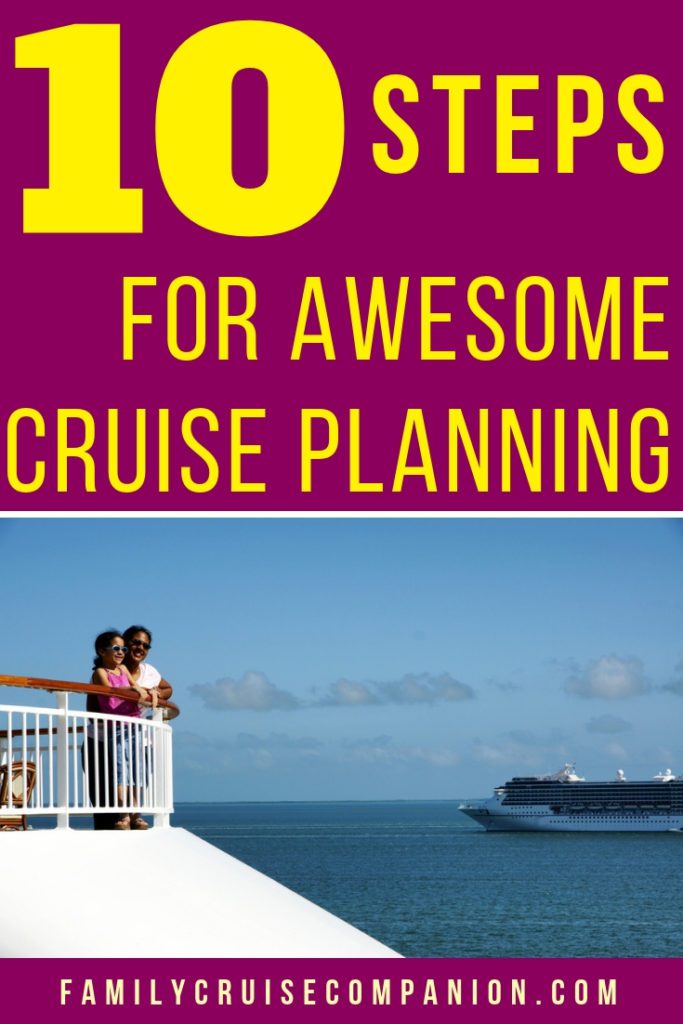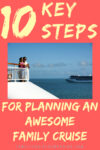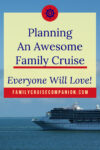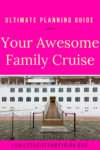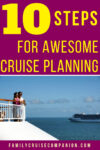If you’re a first-time cruiser, you can easily be overwhelmed by the number of available options for cruises and the numerous decisions points embedded in making a selection. This guide walks through exactly what you need to do to select and plan a cruise that’s just right for your family. You have several key decisions to make. Read on to learn the details and the factors that go into making each one.
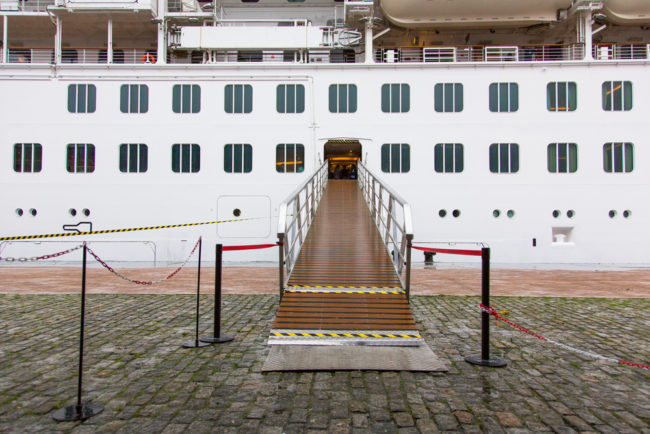
1. Strongly Consider Using A Travel Agent When You Plan A Cruise.
These days, you can make almost all of your family vacation plans online cheaply and efficiently using websites like Orbitz, Tripadvisor.com, and Expedia. But when it comes to planning a cruise vacation, consider getting assistance from a travel agent.
Here’s the basic scoop: There’s a reason why more than 70% of cruisers work with a cruise specialist when booking their trips. Unlike some of your other family travel, booking a cruise on your own without agent assistance will not save you either time or money. And, and you may well miss out on some promotional perks that would add additional value to your trip. As well as missing out on the opportunity to take advantage of subsequent fare drops and sales.
Selecting a travel agent
If you decide to use a travel agent, you should work with an agent who specializes in cruises. They are extremely knowledgeable about every aspect of your trip and can make informed suggestions.
If you don’t have a personal referral, you can search for agents in your area on the websites of relevant professional organizations such as the American Society of Travel Agents (ASTA) (focus on cruise specialists) or Cruise Lines International Association (CLIA).
When you are consulting with a prospective agent, find out whether she has firsthand experience with the brands or ships that interest you. A true cruise specialist has actually been onboard various ships and can provide firsthand advice about the different options available. You should expect something more than the ability to read and summarize from cruise line documentation.
2. Plan A Cruise: Decide When You Want To Sail.
Deciding on the time of year that you want to sail will help narrow your options as you plan a cruise. Cruising for certain parts of the world can be very seasonal. So, if you are limited to a certain time window (e.g., you are restricted to a certain time of year because of school/holiday schedule), and/or if you have your heart set on visiting certain places, this will influence the range of options available to you.
Year-Round Options
Stated broadly, you can generally sail Caribbean, Australian, and Hawaiian itineraries year-round, as well as the Mexican Riviera. For the Caribbean, peak season runs from December through April. Hurricane season runs June through November (with most storms concentrated in August, September, and October). Australia is also a year-round cruise destination. For Hawaii, while you have year-round options for sailings, only Norwegian Cruise Line offers sailings during the summer. The high season for Hawaii runs from late December through April.
Seasonal Options
For Mediterranean itineraries and Alaskan itineraries, the bulk of options will be available in the spring and summer. The Alaskan cruise season runs from May to September. The high season runs June through August. And while there are some instances of year-round options in the Mediterranean, most sailings run spring through fall. For those families that are constrained by school schedules, all of the foregoing itineraries could be viable options for summer break.
Notable itineraries that are largely unavailable in the summer are the Panama Canal, Central America, and South America. Also, options for Far East Asia and Southeast Asia can be very limited. For the Panama Canal, the season runs from October to April. For South America, the season runs from November to early May. Most Asian itineraries run from November through May.
This post may contain affiliate links that could result in payment of a commission to this website (at no additional cost to you). Visit our Disclosures Page for more information.
3. Pick Your Departure Port.
The cruise lines have established numerous departure ports across the United States. Thus, you have many options from which to choose when you plan a cruise. This can play an important role in budgeting when you plan a cruise. You can gain substantial savings on your cruise vacation when you plan a cruise that starts from a location close to home that’s drivable. Or, choosing a port reached by a cheap flight. Alternatively, you can select a more distant departure city and build a few extra vacation days around it.
Many ports have cruises leaving for the Caribbean, e.g., New Jersey, Baltimore, Galveston, and New Orleans. But if you want to maximize the available options, plan a cruise that starts in Florida. Every major cruise line has at least one ship departing from a Florida cruise port. The five different Florida cruise ports are in Fort Lauderdale-Port Everglades, Jacksonville, Miami, Port Canaveral, and Tampa.
Outside of Florida, the following major ports all host several ships from different cruise lines.
Along the East Coast:
- Baltimore, Maryland (Carnival and Royal Caribbean)
- Bayonne, New Jersey (Royal Caribbean and Celebrity)
- Boston, Massachusetts (Holland America, Norwegian, Royal Caribbean)
- New York, New York (Carnival, Crystal, Cunard, Holland America, MSC Cruises, Norwegian, Oceania, Princess, Regent Seven Seas, and Silversea)
Along the West Coast:
- Los Angeles, California (Carnival, Crystal Cruises, Royal Caribbean, Norwegian, Oceania, Princess, Cunard, Silversea)
- San Diego, California (Celebrity, Holland America, Disney, Norwegian)
- San Francisco, California (Cunard, Celebrity, Oceania, Princess, Regent Seven Seas)
- Seattle, Washington (Carnival, Celebrity, Holland America, Norwegian, Princess, and Royal Caribbean)
Along the Gulf Coast:
- Galveston, Texas (Carnival, Royal Caribbean, and Disney)
- New Orleans, Louisiana (Carnival, Norwegian, Royal Caribbean)
Outside of North America, there are also ports across the world for more adventurous travel. For instance, many Mediterranean cruises depart from Barcelona, Rome (Civitavecchia), and Venice; Asia cruises depart from major cities such as Hong Kong, Singapore, and Tokyo; and Australia/New Zealand cruises depart from Sydney, Auckland, Melbourne, Brisbane, and Perth.
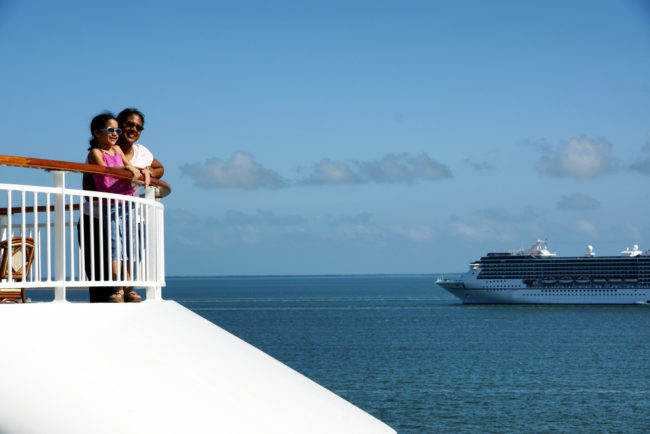
4. Decide How Long You Want To Cruise.
How much time do you have to vacation? Is there a school calendar to workaround? A good starting point is the standard 7-day itinerary. Seven days can be sufficient time to see a few ports, experience a couple of sea days, and gain meaningful exposure to cruising as a vacation. If you are cautious about this new experience, you can also find options for 3 and 4-day cruises.
Also, when you are reviewing potential itineraries, you should note the number of port days vs. sea days and whether there are any “overnights” in port. The actual ports visited will have their obvious appeal (or not), but there is also much to love about sea days. Some itineraries may also include an “overnight” stay in port. This gives you the opportunity to explore more of the city and surrounding environs while still having a place to sleep.
5. Plan A Cruise Within Your Budget.
The amount of money that you have available to spend on a family vacation obviously plays a big role in deciding which cruise to purchase. Here are some general strategies to consider when trying to maximize the stretch of your cruise vacation dollars when you plan a cruise. For more money-saving tips, check out our post on Top Ways To Stretch Your Family Cruise Dollars.
If you are working with a limited or less flexible budget, the first factor to consider is your departure port. Consider driving to a port that is relatively nearby – a day’s drive or less. The savings in airfare and hotel should be substantial.
If you are looking for the best deals, you should try to book early – as in 9-12 months or more in advance. These are usually the best rates available, and you can continue to benefit from any additional price drops or promotions that occur later in the year. You should also look at options during “Wave Season,” which runs from January through March. During this period, cruise lines present their most aggressive offers for the upcoming year.
Finally, investigate planning a cruise itinerary that sails on an older ship. Cruises on older ships are usually much cheaper than the sailings on whatever the latest addition to the cruise line fleet happens to be. Many times these older ships have been recently refurbished or upgraded and can provide great value.
6. Select Your Cruise Destination.
 You can plan a cruise that will take you to almost any part of the world. Looking for a relaxing beach escape? Culture and art? More focused on the resort aspect than any particular destination? You can plan a cruise to some destination that will fit almost every taste. Popular regions include the Caribbean, Alaska, the Mediterranean, Hawaii, South/Central America, Asia, and Australia/New Zealand/ South Pacific.
You can plan a cruise that will take you to almost any part of the world. Looking for a relaxing beach escape? Culture and art? More focused on the resort aspect than any particular destination? You can plan a cruise to some destination that will fit almost every taste. Popular regions include the Caribbean, Alaska, the Mediterranean, Hawaii, South/Central America, Asia, and Australia/New Zealand/ South Pacific.
Here are some quick tips and insights on the most popular itineraries for North American travelers.
Plan A Cruise With A Caribbean Itinerary
The Caribbean and Bahamas are the top destinations for cruisers – attracting more than 35% of travelers. You can book a Caribbean cruise at virtually any time of the year. And there is a wide range of itineraries from 3 or 4 days to 14 days or more (using back-to-back sailings, which some people love).
Related Content: 15 Things Families Should Know For An Amazing Havana Cruise
If the Caribbean appeals to you, you will have a wide range of ships and cruise lines, and a wide range of price points from which to choose. The Caribbean generally is a very accessible location. It is a great option for first-time cruisers, and for families traveling with small children.
Crowding can be a downside of choosing a Caribbean itinerary during certain times of the year. There can be 3, 4 or 5 ships docked on the same day – collectively disembarking 10,000 passengers to visit the shops, sites, and complicating traffic. (For example, the Cozumel Port.) You should also be mindful that many times itineraries change during hurricane season. Sometimes these changes are announced in advance (close to departure), but sometimes changes are made after you have already started sailing.
Types of Caribbean Itineraries
Caribbean cruise itineraries generally fall into three categories: Eastern, Western, and Southern. They break out roughly in the following ways:
The Eastern Caribbean has the largest number of departure port options. It sees cruises departing from Florida, Puerto Rico, and several other ports along the Eastern seaboard. Eastern itineraries commonly include ports in the U.S. Virgin Islands, the British Virgin Islands, St. Martin/St. Maarten, Puerto Rico, Grand Turk, St. Bart’s, Antigua, Anguilla, and Dominica.
The Western Caribbean itineraries can be reached from the Florida ports, as well as New Orleans and Galveston. Western itineraries commonly include Cozumel, Grand Cayman, Jamaica, Honduras, and Belize.
The Southern Caribbean itineraries have ports that require more travel time to navigate. Thus, these cruises tend to be longer in duration. Also, the primary U.S. departure port is San Juan, Puerto Rico. Ships also depart from Barbados and St. Martin. Ports on the Southern itineraries commonly include Aruba, Bonaire, Curacao, St. Lucia, Barbados, Grenada, and Grenadines.
Plan a Cruise With A Mediterranean/European Itinerary
A Mediterranean cruise can be a uniquely enriching cultural experience where you and your family have the opportunity to sample a wide range of “bucket list” experiences. It is an obvious understatement to say that Europe is filled with incomparable art, culture, and history. A cruise ship can be a very convenient and efficient way to travel through Europe with small children in tow. It is on these itineraries that having a floating hotel resort as a base can considerably reduce your travel stressors – no trains, no internal flights, no noticeable passport or customs issues.
One of the biggest downsides, however, is that it can be much more expensive to plan a cruise in Europe, particularly in the peak summer months. First, you have to get there. A ticket to Barcelona or Venice will be substantially more expensive than a ticket to Florida. Air tickets for 3 or 4 people to Europe during the summer can get pretty expensive fairly quickly. Even if you are fortunate enough to have access to frequent flier tickets, the mileage awards will often come with some type of premium. Moreover, prices within Europe are generally more expensive than in the Caribbean, and this can be exacerbated by currency exchange rates.
Plan A Cruise To Alaska
Alaska is another popular bucket list destination that provides an opportunity for a great cruise itinerary. More than half of the visitors to Alaska arrive by cruise ship.
Alaska, which is often referred to as the last great frontier, is a very large territory dominated by thousands of acres of untamed wilderness and a smattering of cities/towns. Some towns can only be easily reached by the water. The massive glaciers and stunning marine wildlife provide a unique backdrop for a family cruise. The natural wildlife both in the sea and on land is its own attraction – humpback whales, Orcas, sea otters, seals, sea lions, wild salmon, moose, grizzly, and polar bears, as well as the largest population of bald eagles in the country. Many outdoor adventures can be found: stunning mountain hikes, dog sledding, fishing, kayaking, and various helicopter excursions only scratch the surface of what’s available.
The Alaska Cruise season runs from May through September. Everything shuts down on a certain date because of weather and habitability issues. There are two primary routes: the “Inside Passage,” which usually runs round-trip from either Seattle or Vancouver; and the “Cross-the-Gulf” itinerary, which involves starting or ending in Anchorage from either Seward or Whittier.
If you find this itinerary appealing, be sure to check out our guide to planning your best Alaska cruise.
Cruising More Exotic Itineraries
The itineraries discussed above generally represent the mainstream in family cruising. But, there are literally hundreds of other ports around the globe that can be visited by cruise ships and they offer a gamut of varied experiences. (So many options exist that you can plan your entire retirement around living on a cruise ship!)
Other areas of the world that host numerous sailings throughout the year include Hawaii, the Panama Canal, and Central America, South America, Antarctica, Mexican Riviera, Canada & New England, Canary Islands, Australia/New Zealand, the South Pacific, numerous countries throughout Asia, Africa, and the Middle East.
7. Select Your Cruise Line & Ship.
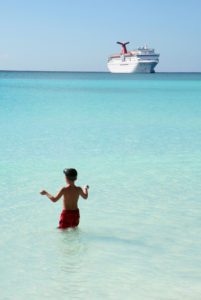 For families traveling with infants or toddlers, you should pay special attention to any restrictions on the ages of passengers when you plan a cruise. These restrictions vary across different lines and different itineraries. Some cruise lines require a minimum of 12 months for all itineraries; some will allow children as young as 6 months on certain itineraries. Generally, cruises that involve long itineraries with many sea days will have higher age restrictions. A typical Caribbean itinerary will more likely to have a lower restriction.
For families traveling with infants or toddlers, you should pay special attention to any restrictions on the ages of passengers when you plan a cruise. These restrictions vary across different lines and different itineraries. Some cruise lines require a minimum of 12 months for all itineraries; some will allow children as young as 6 months on certain itineraries. Generally, cruises that involve long itineraries with many sea days will have higher age restrictions. A typical Caribbean itinerary will more likely to have a lower restriction.
Do You want a “family friendly” cruise?
What makes a particular cruise family-friendly? At bottom, it is a ship that has features and programming designed to enhance the vacation experience of folks traveling with their kids. It is a ship that truly welcomes and seeks out families as opposed to simply tolerating or accommodating them. Some things to look for: Are there age-appropriate activities available? What are the childcare options and opportunities for some adult-only time? Are there activities geared for the whole family to enjoy together? What other features make life easier for families?
Related Content: |
If you review the numerous travel publications and blogs available, you will find a consensus view as to the most family-friendly cruises: Disney, Royal Caribbean, Carnival, and Norwegian (NCL). High marks often also go to Celebrity, Holland America, and Princess. (Focusing on U.S.-based market.)
When researching your cruise options, a good place to start is by assessing the kids’ club options and kids’ programming available on board. Most kid programs start at age 3, and some start as early as 2. Generally, the primary kids’ club will offer free programming during the daytime and early evening. The cruise lines have varying policies as to what extent kids’ club is available on port days, and whether parents may leave their children on-board while they leave the ship.
Character Promotions & Tie-Ins.
Also, for kids’ programming, certain cruise lines have various character tie-ins and character opportunities. On such cruises, there will usually be a breakfast option that can be reserved where characters participate (sometimes for a fee). There will often be numerous opportunities throughout the ship to meet the various characters and take photos. There may be parades and other character-related entertainment. Some characters will also make appearances at kids’ club activities.
Current character tie-ins:
- Disney – Numerous beloved Disney characters such as Mickey and Minnie Mouse. Phineas and Ferb. Elsa and Anna from Frozen. Marvel Superheroes. Various Disney princesses. Star Wars Day at Sea.
- Carnival – Characters from Dr. Seuss’s stories such as the cat from Cat in the Hat, along with Thing 1 and Thing 2.
- MSC Cruises – Legos.
Think About The Size Of The Ship
In recent years, the major cruise lines have been rolling out larger jumbo size cruise ships that can hold 4,000-5,000+ passengers plus a crew of 1500-2000. The biggest of the big right now is Royal Caribbean’s Wonder of the Seas, followed closely by its sister ships – Symphony, Harmony, Oasis, and Allure. Megaships from other lines include Norwegian’s Bliss, Joy, Epic, Escape, Breakaway, and Getaway; Carnival’s Horizon, Vista and Breeze; Disney’s Dream and Fantasy.
The newer ships have been designed and built with dedicated facilities and activities for children. They also have a wider variety of stateroom configurations designed to accommodate families. The megaships tend to be the most family-friendly ships with the most varied and interesting programming that appeals to a wide range of passengers. Offerings may include elaborate water parks, rock climbing, zip lines, bumper cars, ice and roller-skating, surf simulators, 3D movie theaters, go-cart tracks, bungee jumping, and much more.
By contrast, some of the major cruise lines also have ships that serve 1,000 or less. These smaller ships are able to visit places the big ships cannot, but they do not generally offer special activities for small children. For more details for families sailing smaller ships, check out Mom Aboard’s Best Small Ship Cruises To Take With Your Kids.
8. Select Your Cruise Cabin.
The type of cabin you choose could have the biggest impact on your budget when you plan a cruise. A family traveling in an inside cabin will likely pay thousands of dollars less than one traveling on the same ship, same itinerary in a balcony room or suite.
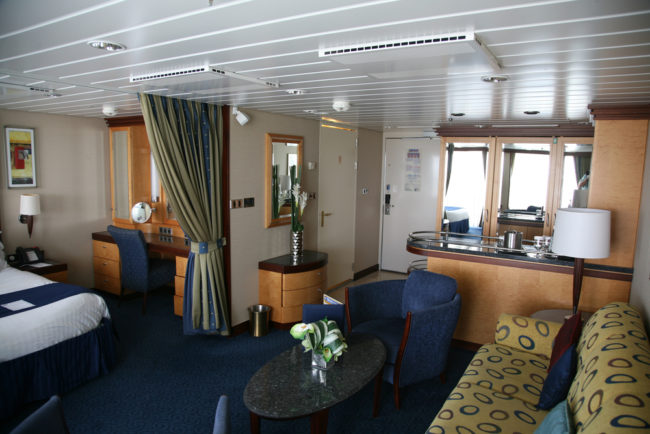 Your choice of cruise cabin can also have a huge impact on your family’s comfort level. Other factors to consider when choosing a cruise cabin include: whether you want access to natural light (interior rooms have no windows); whether you require direct access to fresh air (requires at least a balcony); and the size of your travel party.
Your choice of cruise cabin can also have a huge impact on your family’s comfort level. Other factors to consider when choosing a cruise cabin include: whether you want access to natural light (interior rooms have no windows); whether you require direct access to fresh air (requires at least a balcony); and the size of your travel party.
When you plan a cruise, you can reserve a specific cabin. If you have concerns about motion sickness, the location of your cabin may assist in addressing that. Generally, you will want cabins that have less of a tendency to magnify the motion of the ship. So, you would want one of the lower levels and a room closer to mid-ship.
Likewise, if you have noise concerns, you should avoid the decks that are directly below the pool deck and rooms that are in close proximity to bars, lounges, and other high-traffic areas. Also, cabins that are located on the lower decks and toward one of the extreme ends of the ship are more likely to hear the ship’s mechanical noises.
Related Content: 9 Remarkably Easy Tips To Make Family Cruise Ship Rooms Cozy
Types of accommodations
Inside staterooms
Inside staterooms are rooms without windows. They are usually the smallest sized cabin and will have the cheapest rate.
Oceanview
An oceanview room will be similar to an inside cabin but will have a window or a porthole. This provides the benefit of natural light and somewhat of a view. But the actual size of the window varies based on the ship. It could be a small, obstructed porthole.
Balcony
A traditional balcony cabin will be similar to an oceanview cabin, but it will have an attached private deck that you can physically access. It will typically have at least a table and a couple of chairs. It may also include loungers and other furniture. Advantages of a balcony room include access to fresh air and extra space to roam, which can be good during nap times or when you want a bit of quiet. You could also try for an aft-facing balcony which will typically have a larger balcony space that accommodates more people.
Suites
Suites are typically larger cabins that, at a minimum, will have a defined living space that is separate from the sleeping area. There will typically be a comfortable balcony and several premium amenities. Most ships will have several different types of suites with increasing levels of size and price. Suites often start out at double the cost of a balcony room per person.
9. Take A Hard Look At Travel Insurance.
Regardless of whether you book a non-refundable cruise or one that has some flexibility when you’re planning a cruise, there will be some deadline after which you will not be able to make any additional changes without substantial financial penalties. A wide range of life events can pop, up or things that can go wrong in the several months before a cruise. Given the relative expense, it’s wise to purchase some type of travel cruise insurance when you plan a cruise.
Note that not all policies are created equal and you do not necessarily have to purchase directly from the cruise line when you plan a cruise. In many instances, the cruise line offers may not be your best option.
Common features of a comprehensive policy include coverage for trip interruption, trip cancellation, trip delay or missed connections, baggage loss or delay, medical expenses, medical evacuation, repatriation, involuntary job loss, or pregnancy. A good policy will extend coverage when these events happen to you, or you have to cancel because the event happens to a travel companion. You will also want a policy that provides full reimbursement regardless of when a cancellation occurs.
10. Chart Your Next Steps.
Once you’ve booked your cruise, get ready for a great adventure! But, no matter what cruise you ultimately book, you will still have some additional decisions to make that will greatly shape you cruise vacation and will influence how much you actually spend. Some of the biggest decisions in this regard involve booking shore excursions. And, deciding what onboard packages to buy like drink packages.
We have several posts on shore excursions that can help you sort out those decisions when you’re cruise planning. And, you should also check out our post on cruise line drink packages. We also have advice on what to pack for a cruise, what cruise accessories to take, and cruise mistakes to avoid.
Closing Thoughts:
Would you like a pdf version of this post e-mailed to you? Join our mailing list to get a free expanded version that you can download.
Also, for more comprehensive information about cruising with kids, get the book: The Family Cruise Companion’s Guide to Cruising With Kids.
